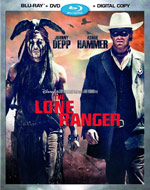
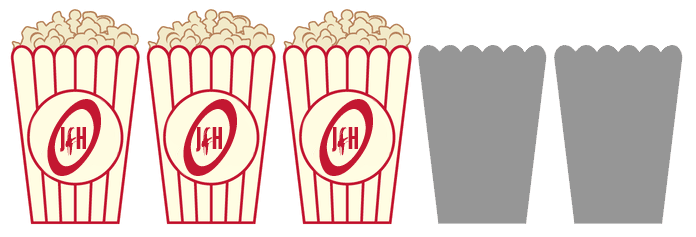
 - for sequences of intense action and violence, and some suggestive material.
- for sequences of intense action and violence, and some suggestive material.
Native American spirit warrior Tonto (Johnny Depp) and man of the law John Reid (Armie Hammer) are opposites brought together by fate and must join forces to battle greed and corruption. (from MovieWeb.com)
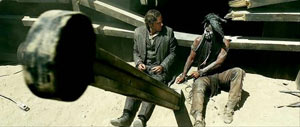
The western seems to be an ailing movie genre. When film was in its golden years, westerns were about as common as anything else you might see in the theaters today. But lately, when Hollywood tries to bring something unique to the big screen in the form of a western, it doesn't quite connect with audiences. I very much enjoyed 2011's Cowboys and Aliens, but the concept alone--cowboys with aliens--had many viewers struggling to buy into the graphic novel-turned-feature film's concept. Perhaps with the success of the more mature True Grit in 2010 lead to The Lone Ranger finally becoming a reality, but the ingredients that were assembled to bring this film to the big screen were not quite the right ones. After all, an American classic hero like The Lone Ranger deserves a fantastic modern update, but it doesn't look like Disney and director Gore Verbinski had everything in order to make that happen.
The Lone Ranger tells the story of a city lawman, named John Reid, who visits the gritty west to visit his brother, one of the town's Rangers. However, a ruthless outlaw takes out all of the Rangers--including Reid, and a local Native American outcast named Tonto helps in resurrecting the Lone Ranger to bring justice to the villain. Verbinski's approach to the story is on par with his Pirates of the Caribbean filmmaking style. In fact, The Lone Ranger feels as if it could exist in the exact same world that Verbinski created for Pirates. You could almost imagine Tonto (played by Johnny Depp) running into Jack Sparrow (also played by Depp) at some point. The world is dark, gritty, and somewhat surreal. Verbinski took a bigger-is-better approach to each succeeding Pirates entry, which allowed for the concepts to get more outrageous with each installment in the franchise. While the first movie, The Curse of the Black Pearl, dealt with cursed pirates who turned into skeletons in the moonlight, things got considerably more fantastical with each sequel. The skeleton pirates were replaced by supernatural fish pirates in Dead Man's Chest, a deceased pirate was raised from the dead, and a sea monster was introduced into the fold. Furthermore, the third film just threw caution to the wind, offering a seemingly infinite number of Jack Sparrows, supernatural crabs, and cast a rock legend to pose as Jack's father. Point being - Verbinski seems to have lost a grip on what feels tangible for the world he creates for his characters. 2011's bizarre animated feature Rango is further proof of this. In The Lone Ranger, there's a spiritual element to the story once again, one that's mostly rooted in the spiritual beliefs of the Native Americans, with the Lone Ranger being a "spirit walker" and there being a horse with strange and unexplainable connections to the spirit world. And, at one point, in a truly George Lucas kind of way, we're shown wild animated rabbits with fangs that are used to illustrate how nature has been thrown "off balance." But it's corny, clearly CG, and something that anyone who has seen Monty Python and the Holy Grail will find utterly ridiculous.
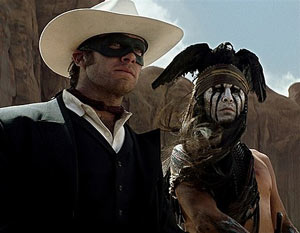
And that's The Lone Ranger's biggest problem; it's a hybrid of genres and tones without ever feeling like it gets any of it just right. Oil and water is an analogy that comes to mind. The story is told in flashback, a decision that doesn't seem to have any good explanation. A little boy who is dressed as the Lone Ranger meets a freakishly elderly Tonto who is unexplainably posing as a statue in a sideshow exhibit and suddenly comes to life. He mistakes the boy for the Lone Ranger somehow and proceeds to tell him the story of John Reid. The two interrupt the story a few times to remind you that they're still there, but ultimately it adds nothing to the story and doesn't really make much sense. If anything, it seems like a way to draw children in to the story, but then Verbinski's direction of the film feels mostly very adult (perhaps the flashback narrative was a demand by Disney in post production to lighten the tone of the movie a hair). Verbinski seems to go out of his way to make the spit and blood of the Old West a visible and real attribute. The camera lingers on bloody imagery and does not cut away from moments that should most certainly be left up to the imagination. Just when you think the violence has been toned down a tad, the camera goes back over a dead body to focus on the bloody clothes and bullet wounds on a dead corpse. It's a most bizarre choice for a supposed "family film." And if it seems like Gore has settled on this more edgy adult approach to the Lone Ranger story, he inserts some oddball humor or imagery to shake things up. And while Jack Sparrow is hardly a serious character, Tonto is presented as a mix of serious with a splash of that Jack Sparrow goofiness. If we didn't already have four (with a possible fifth on the way) movies-worth of Jack Sparrow already, Depp's performance as Tonto would feel entirely fresh, but instead, he offers a mostly new character (for him), with then glaringly similar facial expressions and mannerisms as Sparrow. Otherwise, Depp excels at making Tonto a likeable and interesting character.
The content for The Lone Ranger is a very, very hard PG-13. The worst moment in the movie involves Butch Cavendish hovering over a downed Ranger who's bleeding out. We then see a side view of this as Butch drives his knife into what looked like the stomach region of the Ranger. We then see the Ranger's face as his body moves violently below the frame as Butch apparently starts to cut him open. Reid looks on as this is happening and we see the distorted reflection in his pupil of Butch eating (yes, eating) the Ranger's heart while bending over the man's body. We then see the dead face of the Ranger (eyes are still open) and blood all over his clothes, while Butch has blood all over his mouth. It's pretty disgusting to say the least. Other violence includes characters being shot up and killed, usually with bloody results, and many other kinds of deaths. The finale is pretty brutal, too, with the Indians attacking the soldiers with flaming arrows, while the soldiers shoot back, including with a gattling gun. The language isn't too bad, being mostly uses of "h*ll" and "d*mn," and variations of "Oh my G-d," but there's some sensuality when the duo visit a brothel to speak to Red Harrington (played by Helena Bonham Carter). Inside, they see many buxom women with men drinking and partying. At one point, Red spots a man getting frisky with a woman and Red props her ivory fake leg up on a balcony rail and fires it at the man, telling him "no free rides." Later, we see a soldier lusting after her ivory leg, asking her how far it goes up.
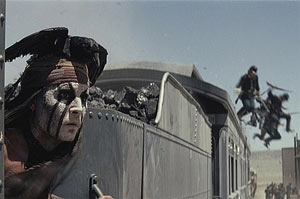
With everything wrong with The Lone Ranger, it's easier to pick out what didn't work over what actually did work. The plot is a bit familiar, if not predictable at times, but the pairing of Armie Hammer as John Reid and Depp as Tonto usually works for much of the film. But by the end of the movie, when Hammer has finally settled in as the Lone Ranger, I felt like whatever adventure they were riding off to be a part of would probably have been a more fun movie than this origin story. Still, the acting is pretty solid in the film (save for Bryant Prince as Danny, the whiney son of Rebecca Reid), and William Fichtner, who is typically an intense actor, is downright creepy as Butch Cavendish. Tom Wilkinson is good as Cole, but the role is all too familiar for him (and I could name at least one other movie from the late 90s that had him playing a similar character, but I won't spoil that here), and Ruth Wilson is pretty good as Rebecca Reid, playing a love interest to the Reid boys who fits the time period without looking like she was lifted out of the page of an airbrushed pin-up magazine. One of the greatest merits of the film is Hans Zimmer's booming score. It's a bit too close to Pirates of the Caribben at times (even the western tune they briefly used in At World's End), but it suits Verbinski's film appropriately, and makes the movie seem a little better than it actually is.
It's too long, it's paced inconsistently, it's way too violent, and it's tonally uneven; The Lone Ranger may still be a watchable summer movie (and not nearly, nearly as bad as Wild Wild West), but you can't help but feel like it should have been better--and that the Lone Ranger deserved a better movie. Verbinski may need to reinvent his directorial approach (or Disney needs to just sever ties with him), as he clearly has lost sight of what makes for good entertainment for the family. A sequel could still be warranted given better direction and story, but as it is, The Lone Ranger is ultimately a glorified misfire.
- John DiBiase, (reviewed: 7/9/13)
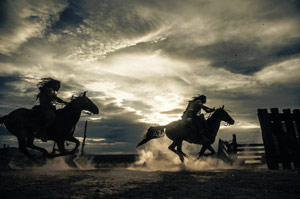
Armies’s Western Road Trip (14:37) - The first featurette is centered around Armie Hammer, who plays the title character in the film, and he talks a lot about his love for road trips and the west. They show some great location scouting in New Mexico, as well as some scenes as they're being filmed. The natives of New Mexico ceremonially welcomed the film crew to the area. This segment really showcases the gorgeous scenery that we can take for granted in special effects-heavy films that forge such scenery. The featurette then takes us to the Mojave Desert in Utah. It's a great short-and-sweet look at the places they filmed at for the movie. (2 "God," 1 "d*mn")
Becoming a Cowboy (8:03) shows how the main actors went through a literal cowboy "boot camp" to learn how to use guns and ride horses and look like pros while doing both. We get to hear from everyone in the main cast too as they reflect on their experiences.
Riding the Rails of The Lone Ranger (10:39) focuses on the trains seen in the feature film. The production built five of the railroad tracks used in the movie from scratch! So some of the scenes that showed the railway actually being built featured real-life railroad builders laying the track. The production also built a couple of the trains used for the movie, with one of them being re-fitted to be used as a different train for a different scene. Finally, we see how they performed a little movie magic to have the train travel through areas that didn't have any track on the ground -- they literally mounted the train cars on flatbed trucks and drove them down a paved road! This is a pretty interesting featurette.
Deleted Scene: Locust Storm/Great Warriors Must Adapt (3:49) - It's apparent that with the film clocking in at 2 and a half hours that very little had been cut out. So this "deleted scene" is mostly just storyboard previs animation! It shows John and Tonto tied up as a locust storm hits, freeing them. There's no dialog, just subtitles laid over animation. The end of the short scene shows them riding off on their horses and then it switches to a live action shot of the kid talking to the elderly Tonto. It's pretty much a throwaway sequence.
Bloopers (3:51) - The blooper reel is worth a watch, too. It just shows the cast goofing off on set, messing up lines, etc. It's not gut-busting funny, but it's entertaining. (1 "d*mn," 1 "h*ll").
That's really it when it comes to the extras. There's no feature commentary either. Gore Verbinski's movies usually have pretty thorough making-of featurettes for them, so this is a little surprising how thin the extras are, but what they included is still pretty good.
- John DiBiase, (reviewed: 12/15/13)
Disclaimer: All reviews are based solely on the opinions of the reviewer. Most reviews are rated on how the reviewer enjoyed the film overall, not exclusively on content. However, if the content really affects the reviewer's opinion and experience of the film, it will definitely affect the reviewer's overall rating.
 Matthew West Performs At "CBS News Presents: A Town Hall With Erika Kirk" Matthew West Performs At "CBS News Presents: A Town Hall With Erika Kirk"Fri, 12 Dec 2025 15:50:00 EST |
 William Lee Golden and The Goldens Release New Music Video For "Old Country Church" William Lee Golden and The Goldens Release New Music Video For "Old Country Church"Fri, 12 Dec 2025 15:30:00 EST |
 Seph Schlueter Caps Breakout Year with Billboard and Mediabase Success Seph Schlueter Caps Breakout Year with Billboard and Mediabase SuccessFri, 12 Dec 2025 15:00:00 EST |
 Declarations Debuts Self Titled EP Declarations Debuts Self Titled EPFri, 12 Dec 2025 14:50:00 EST |
 Compassion Announces Hope of Heaven Tour with Jennifer Rothschild and Point of Grace Compassion Announces Hope of Heaven Tour with Jennifer Rothschild and Point of GraceFri, 12 Dec 2025 14:40:00 EST |
 New Artist Of the Year Leanna Crawford Announces The Sisterhood Tour New Artist Of the Year Leanna Crawford Announces The Sisterhood TourFri, 12 Dec 2025 14:30:00 EST |
 Tommee Profitt's The Birth Of A King Live To Return To Bridgestone Arena in 2026 Tommee Profitt's The Birth Of A King Live To Return To Bridgestone Arena in 2026Fri, 12 Dec 2025 13:30:00 EST |
 Click here All News Headlines |
Click here All News Headlines |